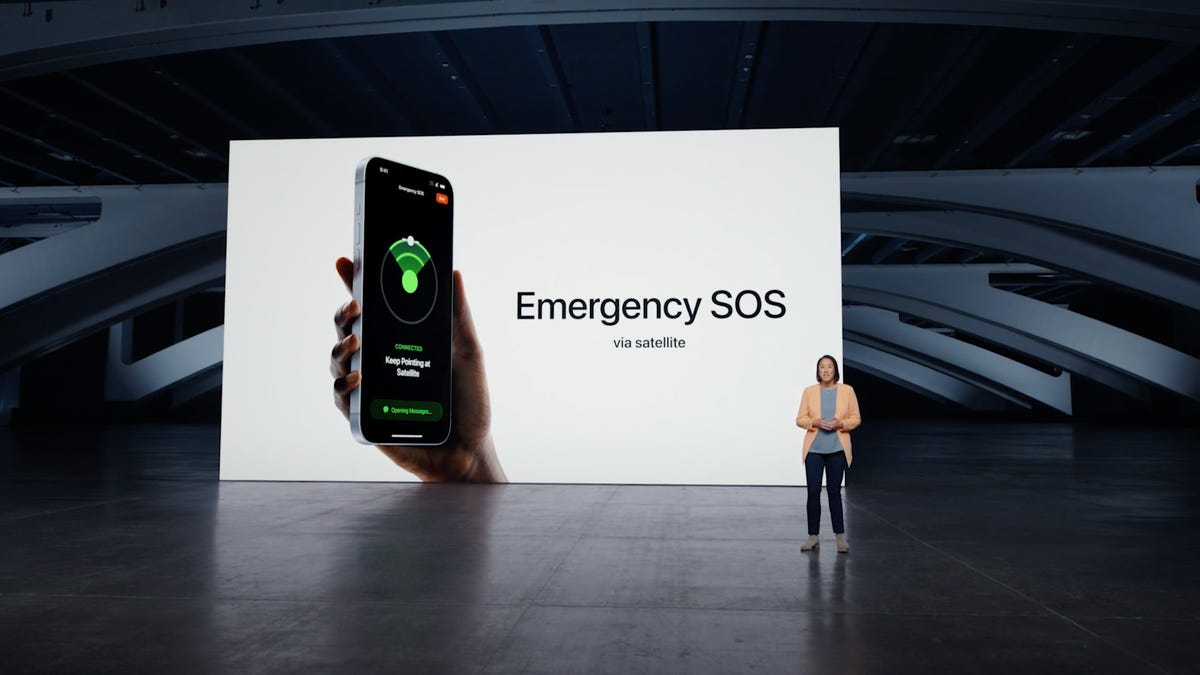 Why You Can Trust CNET
Why You Can Trust CNET Apple's iPhone 14 Emergency SOS Satellite Feature Is a Game-Changer for Safety
It's not a true satellite phone, but it could help connect you to first responders when cellular and Wi-Fi service isn't available.

Apple's Emergency SOS via satellite launches in November.
Apple is adding something new to the iPhone 14 that it hopes you won't have to use: satellite connectivity. Called Emergency SOS via satellite, the new feature is designed to connect you to emergency personnel when traditional cellular and Wi-Fi service isn't available.
Working in partnership with satellite telecommunications company Globalstar, the feature will use Globalstar's network of satellites so you can send text messages from the Messages app to emergency services or contacts when other connectivity options aren't available.
Unlike iMessages -- which has blue chat bubbles when messaging other Apple users, or green bubbles when messaging those with Android phones -- messages sent using this Emergency SOS feature will be displayed in gray bubbles.
Apple's Newest Releases
Messages will be limited in length and will automatically go to the emergency contact's phone, even if they have Do Not Disturb enabled. The feature should be useful to those traveling in remote areas or in places affected by environmental crises, such as wildfires or hurricanes, which often destroy cell towers.
Read more: How Carriers Keep Networks Running During Disasters
The new iPhone 14 will help a user point the phone directly toward a satellite and connect to it. Once that happens, Apple says it will take less than 15 seconds to send a message if the user has a clear view of the sky. In other conditions, such as heavy foliage, it may take a few minutes.
The service will launch in November and be free for two years with the purchase of an iPhone 14. Apple didn't say how much it would cost after that.
Apple was previously rumored to be working on the feature for 2021's iPhone 13, though that never materialized. The company is the latest technology giant to announce that it would be working with satellite companies on new connectivity features for phones. With the iPhone 14, Apple actually will be among the first to launch a product for consumers in this new mobile space race.
Last month T-Mobile announced a partnership with SpaceX that would use the latter's Starlink network to beam connectivity to phones using T-Mobile's midband spectrum. This feature, which is expected to launch in beta "by the end of next year," will also initially only work with messaging apps, though T-Mobile and SpaceX are planning to add voice and data support in the future. Unlike Apple's iPhone 14 satellite program, however, this feature is expected to work with a large number of phones that are already sold by the carrier.
Verizon is aiming to add a similar coverage boost via satellites, and in 2021 announced that it was working with Amazon's Project Kuiper for this service. No timeline for Verizon's launch has been given, and a company spokesman told CNET at the time that the project was "a few years away."



